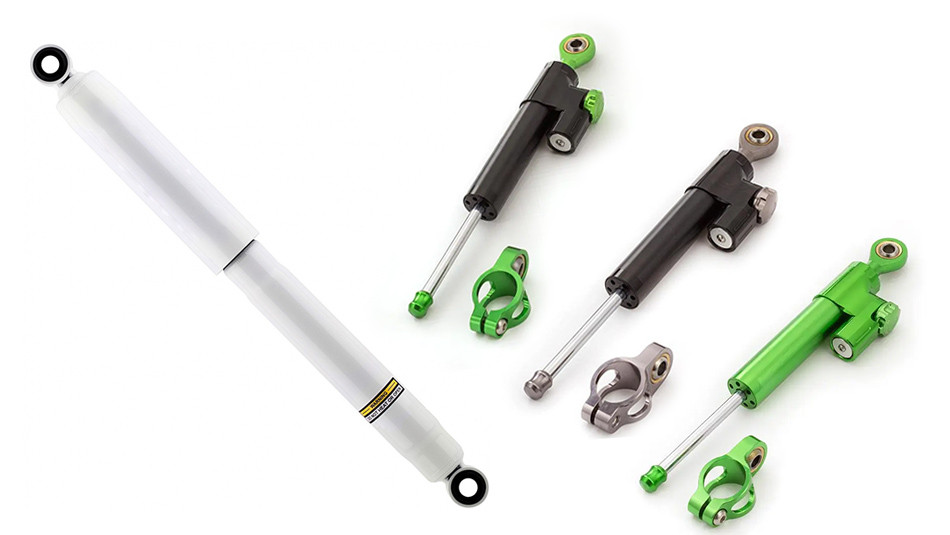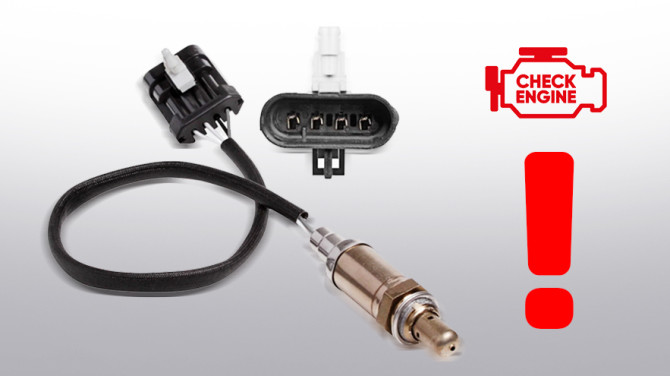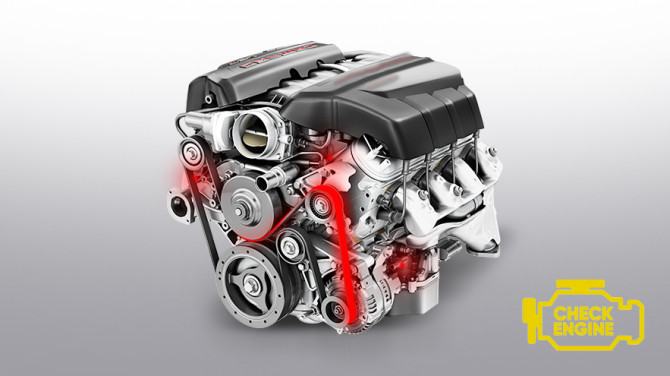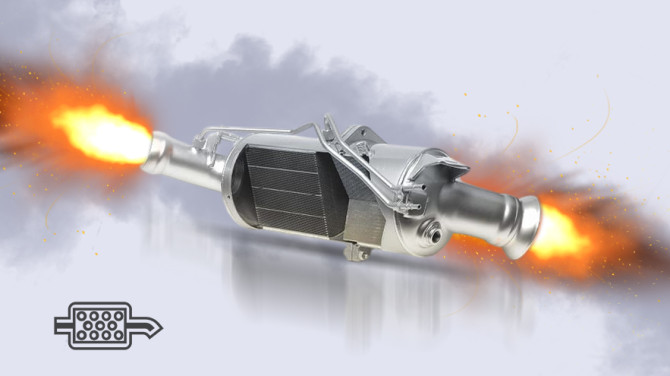Shock Absorber: A Lifesaver for the Steering System

How to protect the steering system from damage? Unfortunately, it's not entirely possible. Failures will occur, but there's a solution to delay them and extend the life of the steering system: the steering system shock absorber.
Steering System Shock Absorber - What is it and why is it necessary?
An automotive steering system shock absorber (Dämpfer in German means damper, buffer, shock absorber) is a device that absorbs some of the vibrations, shocks, and oscillations that pass from the wheels to the steering system components. Another task of the shock absorber is to return the steering wheel to the neutral position and keep the vehicle in a straight line.
In addition to automotive shock absorbers, there are also motorcycle shock absorbers that stabilize the front wheel and handlebars when the rider is traveling at high speeds, accelerating rapidly, or taking the motorcycle out of a turn. Like automotive shock absorbers, motorcycle shock absorbers also reduce vibrations and oscillations from the front wheel to the handlebars.
Due to their design, two types of shock absorbers can be distinguished - telescopic and rotary. Telescopic models are much more common in cars than rotary ones. An exception is sports cars, especially rally cars, where rotary shock absorbers are installed. In motorcycles, rotary units are also more commonly found.
Telescopic shock absorbers work in both compression and tension to minimize vibrations and return the steering wheel to the neutral position. They function similarly to conventional oil and gas shock absorbers with constant or variable damping rates. In the case of units with different damping levels, the driver can adjust the compression and extension force of the shock absorber to suit their driving style and personal preferences. Note: to properly adjust the damping force, you need to understand what and where to set, so seeking advice from a professional is recommended.
Telescopic shock absorbers come in single-acting and double-acting versions. Single-acting models are additionally equipped with an external spring and look very similar to coilover suspension. Double-acting shock absorbers operate on compression and extension without additional external springs.
We won't discuss steering dampers here as they are too rare and make sense only in sports cars designed for off-road driving. At the same time, motorcycle steering dampers are much more common, and such a stabilizer can even be installed in a vintage WSK motorcycle.
Motorcycle steering dampers structurally do not resemble telescopic models at all. The oil chamber in rotary models has a blade instead of a spring. There are two holes in the shock absorber housing through which oil circulates to the shock absorbers. The oil pressure on the shock absorber plate dampens some vibrations and protects the motorcyclist from shaking and jolting. The plate is attached to the motorcycle frame and does not move, while the shock absorber body rotates with the handlebars.
Earlier, steering dampers were manually adjustable, which was inconvenient and could fail at any time. Therefore, over time, manual adjustment models were phased out. In modern rotary shock absorbers, the unit's operation is controlled by the motorcycle's onboard computer. At low engine speeds, the oil openings are fully open, and the handlebars move freely. The harder the rider accelerates, the more the computer narrows the oil openings, increasing the tightness of the steering system. Thus, at high engine speeds, the handlebars become much heavier and tighter to minimize the risk of highside (in biker slang, "highside" means falling off the motorcycle).
Classification, construction, and operation principles of shock absorbers are clear, so let's move on to the advantages and disadvantages of stabilizers to find out if they are necessary.
Advantages and disadvantages of car telescopic steering system shock absorbers
Advantage #1: Reduces shocks, vibrations, and oscillations
During driving, the greatest loads go to the wheels, and from them to the steering system and suspension components. The shock absorber reduces all wheel impacts on the steering system and the steering wheel by 30%. Now, when you drive over cobblestones, tram or train tracks, cracks, and bumps in the asphalt, the steering wheel won't rattle like crazy and won't jerk your hands.
The shock absorber also extends the life of steering system components. Whether you have a gear reducer or a rack, the steering system shock absorber:
- reduces the kickback to the power unit (if installed);
- protects steering system parts from wheel vibrations, shocks, and oscillations;
- increases driving comfort and vehicle stability.
In short, after installing a shock absorber, driving becomes easier and more comfortable, and there are fewer steering system repairs (provided the shock absorber is installed correctly and the steering system was not previously damaged).
Advantage #2: The shock absorber protects the suspension from knocking
Logically, if the steering system is less wobbly, the impact on the suspension is also reduced. No need to elaborate - let's move on.
Advantage #3: Thanks to shock absorbers, the steering system response is smoother
This positive effect is particularly noticeable when driving at high speeds on the highway. The steering system is smoother, making it much easier to steer at higher speeds.
Disadvantage #1: "Heavy steering"
Many drivers have noticed that after installing a shock absorber, the steering wheel seems heavier. This effect is particularly noticeable at low engine speeds and in older cars without power steering. However, this cannot be considered a disadvantage, as the effect is minor, and drivers quickly get used to it.
Disadvantage #2: The shock absorber can get clogged
Yes, like any moving part, the shock absorber can get clogged. If dirt or contaminants get inside the shock absorber, it will get clogged and won't dampen vibrations. On the contrary, a clogged shock absorber will be very uncomfortable to drive and can cause serious steering system malfunctions. However, you can easily protect the throttle from clogging by installing a dust cover. It is essential to consider the shock absorber stroke, housing diameter, and the moving shaft. A dust cover will protect the shock absorber from clogging and extend the life of the assembly. Just periodically check the condition and replace the worn-out cover at the right time.
A shock absorber with a dust cover has a longer lifespan and looks more aesthetically pleasing.
Disadvantage #3: A shock absorber with a return spring makes the steering wheel return to the neutral position, even if you don't want it to
If the car has a weak and outdated power steering system, a return spring shock absorber will interfere with steering. It will try to return the steering wheel to the neutral position, even if the driver hasn't finished turning. And if you don't apply additional force to the steering wheel, the shock absorber will gradually "defeat" the steering system and return the steering wheel to the neutral position.
Note: this disadvantage only applies to a poorly functioning power steering system. Modern hydraulic and electric power steering systems work well with a return spring shock absorber.
Conclusion: What should you choose - with or without a shock absorber?
In 90% of cases, we recommend installing a steering system shock absorber, especially if you own an older car. Shock absorbers have been installed in all vehicles since the 2000s, and many modern vehicles have electric power steering systems, making the shock absorber an essential component.
If your car is not equipped with a shock absorber, it's a good idea to install one. Just don't forget that the shock absorber is not a cure-all, and steering system malfunctions will still occur. The shock absorber will only slow down the process of wear and tear on the steering system and protect the vehicle from excessive vibrations. So if you care about the condition of your car and your safety, install a shock absorber in your car and replace it on time. And, of course, don't forget to periodically check the dust cover for wear and replace it as needed.
How and where to install a steering damper on a vehicle?
Decided to install a damper on your car? Good. Then you need to know how and where to install it. The answer to the question "How to install a damper?" is very simple - contact professionals at specialized service stations or use the instructions included in the box with the damper.
If you've taken the easy route and gone to an auto service, there's nothing to worry about, the specialists will do everything for you. If you're not looking for easy solutions and intend to install the damper yourself, carefully read the instructions and only then start unscrewing and installing anything. It happens that there are no instructions in the box with the device. In this case, simply go to the damper manufacturer's website and find the instructions there.
We'll warn you right away: to install the damper, you'll need a sizeable set of shaped, nut, and ring spanners, several attachments and extensions, and some experience. The sizes of the wrenches are chosen according to the model and dimensions of the damper. So when you buy a damper, immediately inquire about which wrenches you'll need so that you don't have to run around the city later looking for the necessary tools.
Where to put the damper? There are 6 position options for the damper - 3 for rack steering and 3 more for steering trapezoid with a gearbox. Let's start with the racks:
- The most popular version of the steering rack design is a unit where the steering rods are attached to the ends of the horizontal rod. In this case, one end of the damper is attached to the rack body on a bracket, clamps or bolts, and the other - to one of the rods using a special washer with fasteners for the shock absorber.
- There are racks where the steering rods are attached not to the edges of the rod, but to the center using a special clamp. In this case, one end of the damper is attached to the rack body, and the other - to the clamp with the rods. In this and the next case, the damper dampens vibrations and oscillations from both rods at once.
- In some cars, for example, Audi 80 1984-1986, Audi 90 1984-1991 and Volkswagen Passat 1973-1980, there are racks on which the rods are attached to one end. As in the previous case, the rods are installed on a special clamp, which is then attached to the rod. The damper on such racks is attached to the rack body and the clamp with rods.
The situation with gearboxes is somewhat different - the position of the damper depends not on the design of the gearbox, but on the design of the steering trapezoid and the under-hood space. Three ways to install a damper on a steering trapezoid with a gearbox:
- The damper is attached to the long steering rod and to the bridge so that the unit is located above the steering rod. In this case, the damper is quite close to the wheel and, theoretically, dampens all oscillations and vibrations at the source. At the same time, such placement of the damper can affect the service life of the unit itself. In addition, it's worth considering the design of the under-hood space so that when the suspension is maximally compressed, none of the elements of the bridge, body or suspension hit the damper.
- The second option is very similar to the first, as the damper is also attached to the bridge and long steering rod. However, in this case, the damper is either at the same level as the rod or below it. The disadvantage of this design is that the damper is too close to the ground, and if you hit a stone or something while crossing off-road, it's the end for the damper.
- The third and final option for installing a damper on a steering trapezoid with a gearbox is to place the unit on a short steering rod and frame. In this case, the damper is high enough above the ground. However, even under such conditions, one should take into account the peculiarities of the under-hood space arrangement so that none of the elements of the body, frame or units hit the damper.
Some motorists who seek to maximally protect the vehicle's steering from premature wear and unexpected malfunctions install two dampers at once. One shock absorber is installed on the long rod, the other on the short one. Such designs are most often found on the steering of large SUVs, whose drivers like to drive through fields, cross small rivers and storm mountain slopes. In simple words, two dampers are installed by fans of extreme driving.
Important information for all drivers who decided to install a damper on their vehicle's steering themselves. During installation, one should keep in mind one nuance common to all the above-described options for damper placement. Both damper mounts are protected by special bushings so that the unit works for the stated term and doesn't break earlier. When installing the damper, the protective bushings of the mount should be in a neutral position.
As you've already understood, to install a damper, you need to prepare seriously and choose the right place for its installation. If you're not 100% sure that you can handle this on your own, it's better to seek help from experienced specialists.
We're done with car dampers, now let's talk a bit about motorcycle dampers.
General information on dampers for motorcycles
As mentioned above, rotary dampers are more often installed on motorcycles, but some motorcyclists prefer the usual telescopic models. We've already looked at the design differences between these two types of dampers, now it's time to determine which motorcycle damper is cooler, and also how and where to properly install each of the unit options.
In terms of reliability, rotary dampers win with a small margin. They have a stronger construction that allows them to withstand more load than is possible for telescopic analogues.







